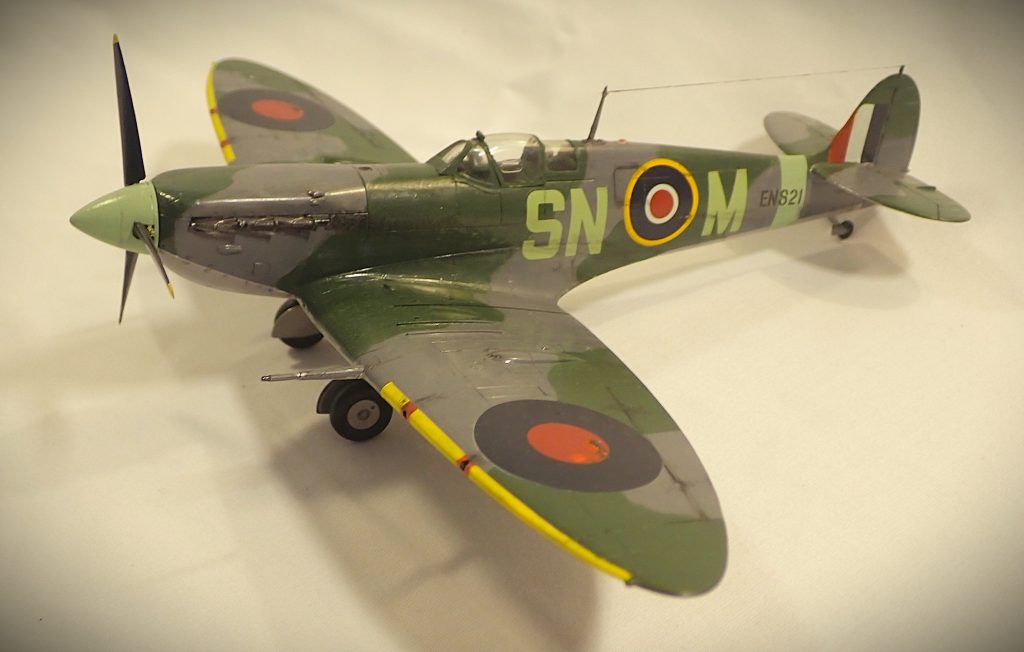After the advent of the Spitfire Mk.I & Mk.II in 1937 work began on improvements immediately. There was a planned Mk.III using the new Merlin XX, but only one was completed. The more advanced Spitfire Mk.V powered by the Merlin 45 initially was the next production model which entered service in three versions, MK.Va, Mk.Vb and Mk.Vc. The last letter referring to the wing configuration. The slightly redesigned wing was interchangeable and differed only with the gun arrangement. The ‘a’ wing was the standard four Browning .303 in each wing, the ‘b’ wing was one Hispano 20mm cannon inboard and two Browning .303 with the ‘c’ wing being equipped with two Hispano 20mm cannon in each wing. The Mk.Vb was the most common configuration. The Spitfire Mk.V was the first to adapt to carry bombs or external fuel tanks.
The Spitfire Mk.V was the first to use the F letter to denote Fighter and there were also LF, Low level Fighter and HF, high level Fighter. The Mk.V entered service in February 1941 with 92 Squadron and began to replace all the worn-out Mk.I’s and Mk.II’s. Subsequent production models used the improved Merlin 46, 50 and 50A. The Mk.V was faster than its predecessors and could reach speeds of 370mph. For a while it outclassed the best German fighters but with the Introduction of the Fw190 in late 1941, the Mk.V was itself outclassed. During early 1942 many losses were incurred over France and the Low Countries while engaging Fw190’s but the RAF had to wait anxiously for the Mk.IX to appear a few months later. However, the Mk.V remained in frontline service until mid-1943 when it was relegated to secondary roles. It was superseded by much improved versions of itself, especially with the Rolls-Royce Griffon engine types.
The Mk.V was the first version to be sent overseas and saw action in the Mediterranean and North Africa, as well as Burma and Australia. Many Spitfire Mk.Vs were sent to Malta for the initial defence, and several Squadrons were equipped with the type in support of Monty’s drive across North Africa.
The Mk.V total construction was 6,479 most of which were the Mk.Vb with 3,911 being built. The vast facility at Castle Bromwich was responsible for producing most of all versions of the Spitfire, over 20,000.
There are many Spitfire Mk.Vs on static display around the world. You can even see a version in Serbia!
There are many airworthy examples still flying today, a true testament to the staggering success of this British fighter. There are six in the UK alone listed below:
Spitfire LF Mk.Vb AB910 with the Battle of Britain Memorial Flight built in 1941 at Castle Bromwich.
Spitfire LF Mk.Vc AR501 of the Shuttleworth Collection built in 1942 and featured in the Battle of Britain movie in 1969.
Spitfire F Mk.Vb BM597 owned by the historic Aircraft Collection built in 1942.
Spitfire F Mk.Vc EE602 , built 1942 and served in Burma, restored at Biggin Hill and flew again in 2015.
Spitfire LF Mk.Vb EP120 owned by the Fighter Collection at Duxford. Built at castle Bromwich in 1942 and served with 501 Squadron, crashed, repaired and reassigned to 19 Squadron. Also starred in the Battle of Britain movie.
Spitfire F Mk.Vc JG891 operated by Commanche Fighters with the help of Aircraft restoration Company. Built in 1942 and served with the RAAF in Australia.
